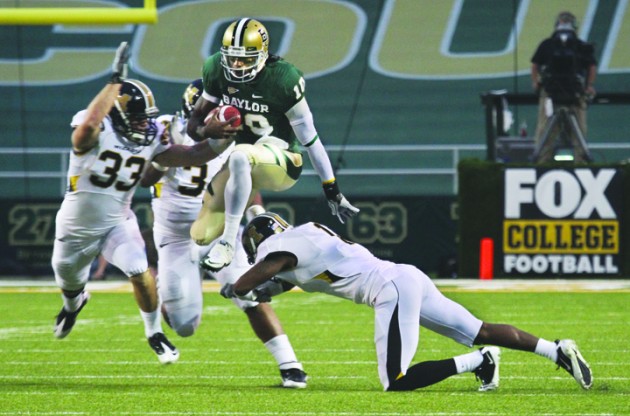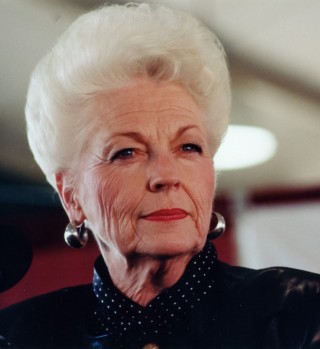
Matt Hellman | Lariat Photo Editor

Wikimedia Commons
By Trevor Allison
Reporter
The past two years have been full of success for Baylor’s athletic programs, but there has also been uncertainty regarding Baylor’s conference affiliation.
Ian McCaw, Baylor director of athletics, said conference affiliation is important not only for athletics but for many aspects of the university, including donor relations and future student applications.
“In my view, Baylor being in the Big 12 is one of the university’s greatest assets,” McCaw said. “It brings significant national exposure and a platform for competition in national sports.”
Despite its national profile, the Big 12 has faced some uncertainty the last two years.
It began in June 2010 when the University of Colorado left the Big 12 to join the Pacific 10 (now Pacific 12) Conference and the University of Nebraska left to join the Big Ten. There were reports that the University Texas and other Big 12 schools, possibly including Baylor, received offers to join the Pacific 10, but the University of Texas decided to stay in the Big 12, with the other schools following suit.
Then, in August 2011, the University of Missouri and Texas A&M University decided to leave the Big 12 for the Southeastern Conference. This led to another period of uncertainty for the Big 12, with other member schools deciding whether to pursue a new conference affiliation for themselves. At this point, it was very uncertain where Baylor might land in the case of a Big 12 collapse. The unrest was settled when the Big 12 announced it would replace the outgoing schools with West Virginia University from the Big East Conference and Texas Christian University from the Mountain West Conference.
McCaw said even though several teams have departed from the Big 12 in last two years, it has been preserved through the actions of many, including Baylor President Ken Starr, and has a “bright and stable future as a result.”
But there was also another time when Baylor was almost left without a conference home, much less one with the national scope of the Big 12.
Dr. Dick Ellis, Baylor director of athletics from 1993-1996, said the recent departures of the University of Nebraska, the University of Colorado and Texas A&M University from the Big 12 and the University of Texas’ threat of leaving are similar to what happened with the Southwest Conference. Baylor was a part of this conference from 1915-1996. Ellis said Texas looked into joining the Pacific 12 or the Big Ten, back in the 1990s as well as last year, and, like in the earlier event, decided to stay in their current conference.
Ellis said the Southwest Conference (SWC) began to have less of a national impact in 1991.
“After Arkansas left to join the SEC [Southeastern Conference], we [SWC] were, in fact, a more regional conference with all the schools in the state of Texas,” Ellis said.
Historian Jay Black, of the Texas Sports Hall of Fame, said other factors were also contributing to the doubtful future of the SWC.
“The lack of a television deal was a major weakness of the SWC,” Black said.
He said the conference was also weakened by schools that were on probation with the NCAA for various rules infractions, such as Southern Methodist University and Texas Christian University.
Ellis said those involved in the SWC knew it needed to make some changes to stay relevant on a national scale.

“Initially, in the mid-’90s, our conference leaders began to look at an alignment with the Big 8 conference where we would schedule several inter-conference games in all sports,” Ellis said. “Even though we had initially talked about a SWC and Big 8 scheduling agreement for non-conference games, eventually the thought process led to the creation of the Big 12.”
In the fall of 1995, the University of Texas began entertaining suggestions of leaving the Southwest Conference, he said. Administrators at UT took the lead in negotiating with the Big 8 to add teams from the SWC.
Ellis said UT and Texas A&M University were the primary schools of interest for the Big 8, but the political situation in Austin worked in the favor of Baylor and Texas Tech.
“Ann Richards, a Baylor grad, was governor, which helped us,” Ellis said. “But the real strong man in Austin was Lt. Gov. Bob Bullock, a Texas Tech graduate with a law degree from Baylor.”
Ellis said he, then-Baylor President Dr. Herb Reynolds and then-Baylor Chair of the Board of Regents Tom Powers made many trips to Austin and many phone calls during this time. But the real key was the Baylor connection with Richards and Bullock, he said.
“Adding UT and A&M would have worked for the Big 8, but the political powers in Austin pressured the dealmakers to ensure that Tech and Baylor would make it four schools,” Ellis said.
Once the deal was made to expand the Big 8 to the Big 12, Ellis said he and the other athletic directors and presidents went through the extensive process of planning the new conference.
“We went through a process of creating new conference rules and by-laws, setting up marketing and promotions, signing new television contracts and creating new schedules and conference championship events,” Ellis said. “Almost over night, the Big 12 became one of the premiere conferences in the country.”



